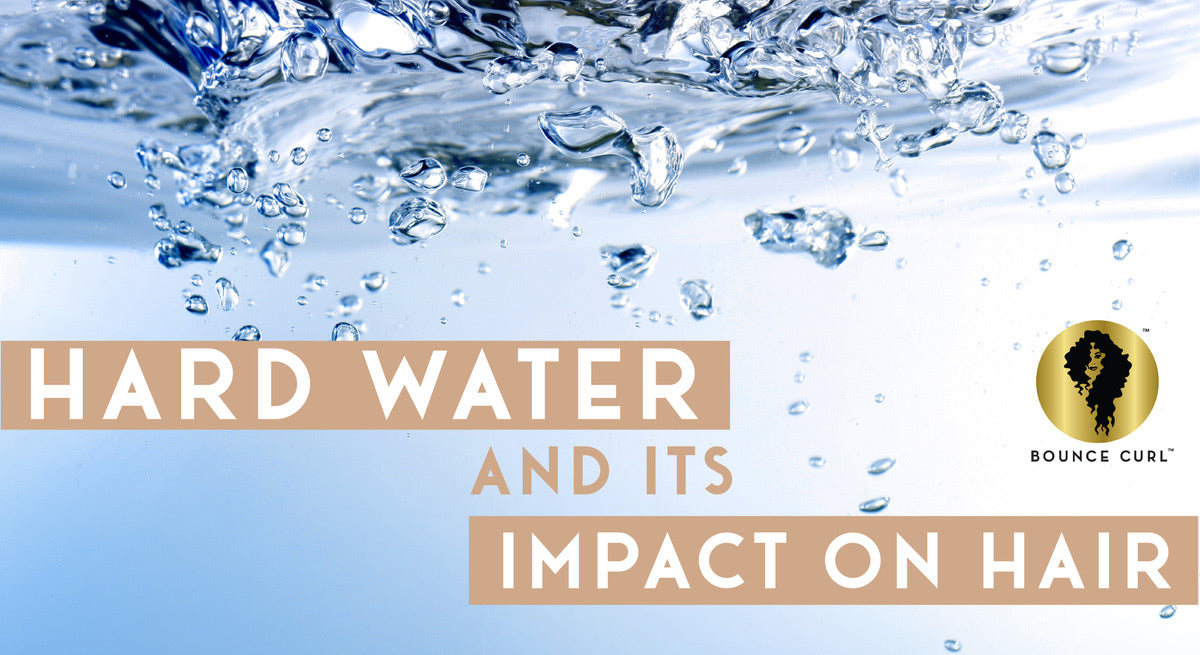
Hard Water and Its Impact On Hair
Water is a vital element without which we cannot survive. It has special chemical properties, like being a polar molecule, that enable it to dissolve other chemicals, minerals, and ingredients.
Polarity also makes it an excellent wetting liquid that provides its detergency and ability to clean and remove debris from dirty clothes, our hair, and skin.
However, water quality sources can differ. Water quality is defined by the presence of organic or inorganic materials present in water, and it has an immense impact on our health and overall well being.
Because water is the sole solvent that can cleanse hair and skin, hard water can have a negative impact on both.
But what exactly is hard water, and how does it affect our hair?
What Is Hard Water?
The simple definition for hard water is "water containing significant amounts of dissolved minerals."
The two main metal ions responsible for these changes are calcium and magnesium. When present, they change the physical and chemical properties of water which then alters its potential power as a detergent or cleanser.
Hard water is water that contains high levels of calcium and magnesium ions, and the measurement of these minerals in water describes "water hardness."
The sum of both calcium and magnesium is determined experimentally and called "total water hardness."
Calcium and Magnesium
So, the question that follows is, why is their presence called or termed "hard"? The answer is because both calcium and magnesium make it "hard" for water to clean objects.
Did you know that when you wash your hands with soap and water, sometimes a white film appears almost immediately? This is called "soap scum."
Soap scum is made of long-chain fatty acid salts of calcium and magnesium which become insoluble during washing.
The term "hard water" comes from the fact that soap can't properly clean under these conditions, which makes it more difficult to do the cleaning.
The World Health Organization (WHO) and almost every country have standard limits for both calcium and magnesium in water.
Soft water contains 0 to 60 mg/L (milligrams per liter) of calcium and magnesium, while anything above this is hard water. Water hardness increases as the amounts of both metal ions also increase.
Cause of Water Hardness: Source of Metal Ions
The main cause of water hardness is carbonates, bicarbonates, and chloride salts of calcium and magnesium.
These metals are abundantly present in the earth's crust. They exist in rock, e.g., limestone, chalk, gypsum, and dolomite.
One explanation for why metal ions are present in water is when rainwater dissolves these minerals.
Another potential source of these metal ions is sewage, agricultural waste, and other industrial wastewater.
Metal Adsorption on Human Hair
There are two assertions for the metal content of human hair.
- First, the metals present inside the hair fiber are due to natural keratinization and biochemical processing in the hair follicle.
- Second, if we take a closer look at different parts of the hair fiber under a microscope, we can see that metals are bonded to multiple amino acid sites. While the levels of these metals are minimal, they actually serve an important purpose in the hair's life cycle.
Most of the metals on hair are found at its outer surface, the cuticles. Scientific studies have identified various metals such as calcium, magnesium, copper, and manganese, etc.
It is believed that these metals are adsorbed onto the hair surface from external sources, with tap water being the main player. If the calcium and magnesium level is high in your tap water, your can hair absorbs these metal ions.
Not only have multiple research groups noted these findings in scientific journals, but bleached and damaged hair is found to contain higher metal content.
Calcium and magnesium metal ions are cation, meaning they have positive charges. The amino acid sites on hair have negative charges.
What do we know about magnetism?
Opposite charges attract, which means that these metal ions will bind electrostatically to the amino acid sites in the hair structure.
Positively charged cations of calcium and magnesium bind with negatively charged carboxylates sites of amino acids.
Damaged hair, particularly the damage done by hair bleaching, permanent dyeing, and alkaline treatments, has a relatively higher number of negative sites, which is why damaged hair has higher amounts of calcium and magnesium compared to undamaged hair.
Impact of Hard Water on Hair
Water hardness has serious consequences for our hair care, such as;
- Metal adsorption at the hair surface can alter the surface properties of hair.
- Chemically treated hair has higher metal uptake leading to potentially undesirable metal build-up.
- Metal adsorption hinders the uptake of essential active ingredients. In addition, they compete against cationic ingredients for binding sites, as both metal ions and conditioning agents target the same negatively charged sites - meaning, a high presence of calcium and magnesium at the hair's surface can undermine the performance of your conditioner.
- Poor curl retention or difficulty in maintaining a desired hairstyle is more common with hair that has higher metal levels, therefore water quality is extremely important for those with curly hair.
- Hair scientists have reported that hair becomes stiff and difficult to style. This is potentially due to changing hair charge density, and having a uniform coating of hair styling products at the hair surface.
- The overall sensory features - touch, and feel for hair also changes.
How to Control Metal Uptake?
Follow these simple steps to reduce the amount of hard water metals that your hair absorbs:
3 ways to use our detox mask:
- Scalp detox
- Add to your shampoo
- Full scalp and hair detox. Make sure to keep it in for 10-15 min and rinse!


Leave a comment